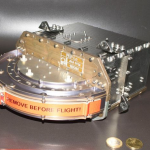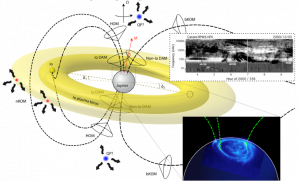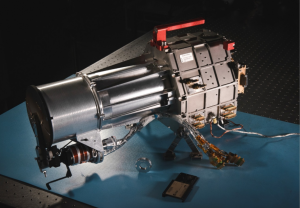
The Ganymede Laser Altimeter (GALA): Onboard JUICE:
The JUpiter ICy moon Explorer (JUICE) is an ESA-led mission with strong involvement from Japan. The “ONBOARD JUICE” series looks at the instruments on JUICE for which Japan has contributed hardware or expertise. An introduction to the mission and instrument overview can be found [here].
Author: Enya Keigo, lead researcher for GALA-Japan
Quick fact sheet: GALA

The Jupiter Icy Moon Explorer (JUICE) is scheduled to be launched in April 2023. JUICE is a science mission led by the European Space Agency (ESA) to observe Jupiter’s icy satellites—especially the moon Ganymede—in detail from orbit. Ganymede’s surface topography is mainly composed of water ice, and is quite different from that of the terrestrial surface. Investigating the topography of such an icy world leads further understanding of how such a world was formed, and how the world has evolved, which are key issues in planetary science. It has also been pointed out that a subsurface ocean composed of liquid water may exist on Ganymede. From the viewpoint of not only planetary science, but also astrobiology, it is highly important to determine whether a subsurface ocean exists or not, and to reveal its characteristics if it should exist.

The Ganymede Laser Altimeter (GALA) is one of the science instruments onboard JUICE. Simply put, GALA’s function is to measure distances with high sensitivity and accuracy. Development of GALA was conducted by an international collaboration amongst Germany (lead), Japan, Switzerland, and Spain. We, the Japanese team, are responsible for the development of the Backend optics (BEO), the Focal Plane Assembly (FPA) including the APD detector, and the Analogue Electronics Module (AEM).
The BEO is an optical system that significantly improves the signal-to-noise ratio of extremely weak received laser light and re-images it on the detector in the FPA. The FPA converts the received light into an analogue electrical signal by the internal APD detector and outputs this signal. The FPA also has an optical path that introduces a small fraction of the transmitted laser pulse light into the APD detector. The purpose of this optical path is to realise time difference measurements of transmitted and received light by the same detector and use this to make highly accurate distance measurements. The AEM converts the analogue electrical signal from the FPA into a digital output so that subsequent systems can handle the data. These developments were not easy because the signals handled are diverse (optical, analogue-electrical, and digital), and are mechanically and thermally complex. Through these developments, the Japanese team has made important contributions to GALA, which will perform distance measurement with high sensitivity and accuracy.


GALA will scan the surface of Ganymede from orbit around the icy moon (500 km altitude) by continuously repeating the high precision distance measurements to the Ganymede surface. This will uncover the 3D features of the icy topography across the entire sphere of Ganymede, and determine whether there exists any small deformations in Ganymede’s overall shape, which should occur if the moon harbours a subsurface ocean. GALA’s measurement accuracy has been evaluated to be capable of detecting even deformations caused by the tidal effects induced by the gravity of Jupiter and neighbouring moons, estimated to be a few meters, ∼7 m maximum.
Further information:
The JUICE Mission: Japan joins ESA to head to the icy moons
GALA Fact Sheet
JUICE Japan website
Technical references:
- H. Hussmann et al., “The Ganymede laser altimeter (GALA): key objectives, instrument design, and performance”, CEAS Space J., 11 (2019), pp. 381-390.
- G. Steinbrügge et al., “Measuring tidal deformations by laser altimetry. A performance model for the Ganymede Laser Altimeter”, Planet. Space Sci., 117 (2015), pp. 184-191.
- J. Kimura et al., “Science objectives of the Ganymede Laser Altimeter (GALA) for the JUICE mission”, Trans. JSASS Aerospace Tech. Japan, 17 (2) (2019), pp. 234-243.
- H. Araki et al., “Performance model simulation of Ganymede Laser Altimeter (GALA) for the JUICE mission”, Trans. JSASS Aerospace Tech. Japan, 17 (2) (2019), pp. 150-154.
- K. Enya et al., “The Ganymede Laser Altimeter (GALA) for the Jupiter Icy Moons Explorer (JUICE): Mission, science, and instrumentation of its receiver modules”, Ad. S. R., 69 (2022), pp. 2283-2304.
 Previous Post
Previous Post Next Post
Next Post






